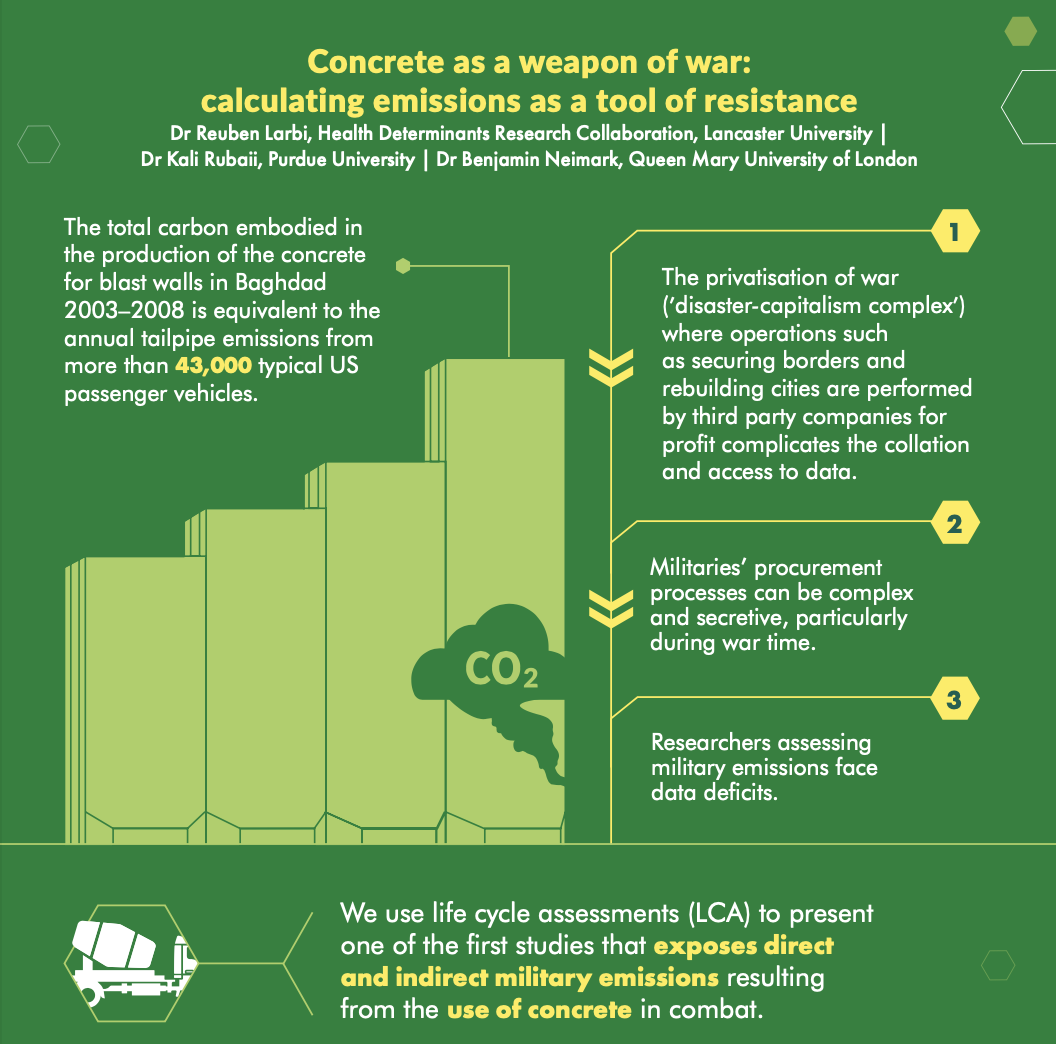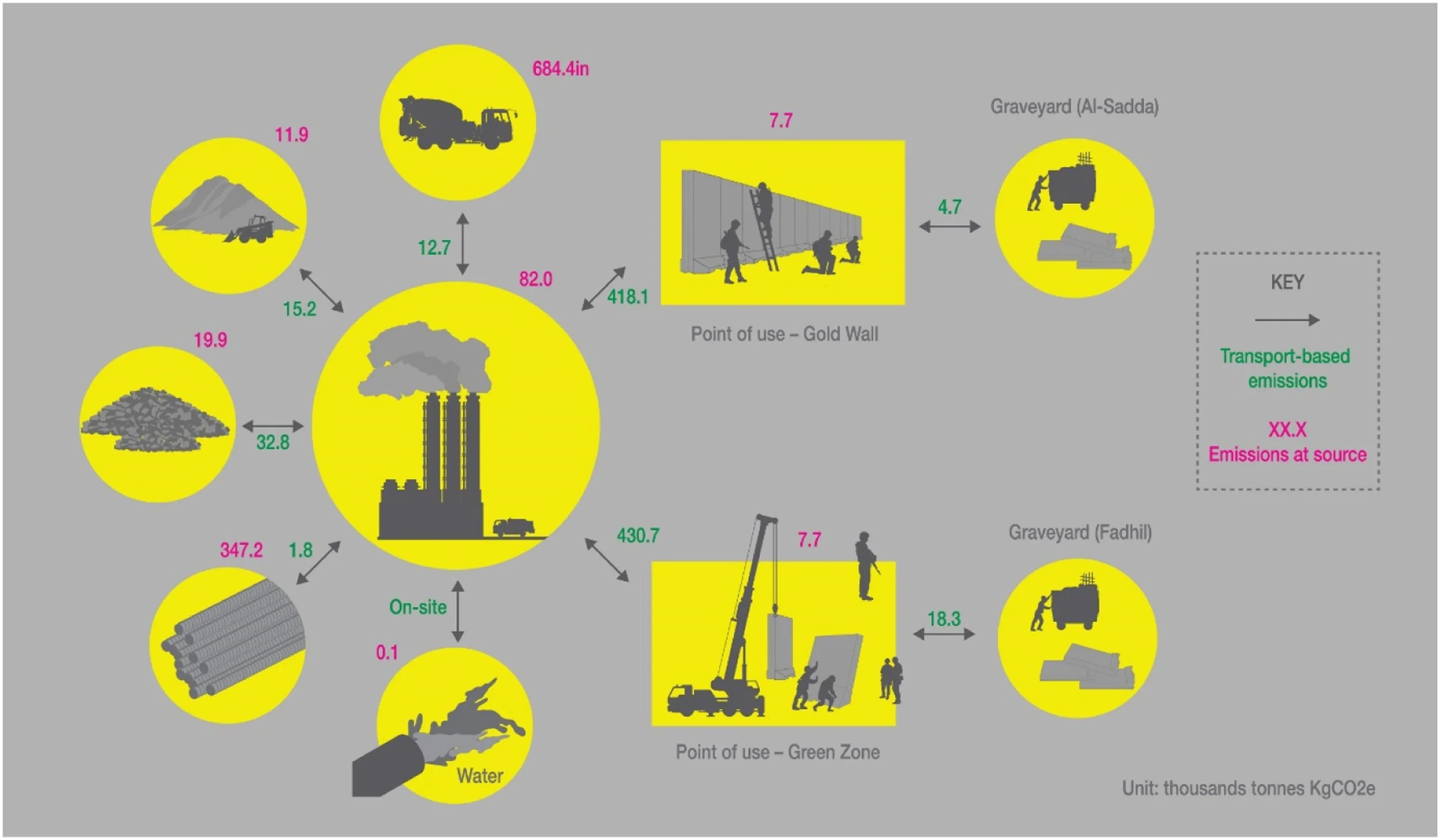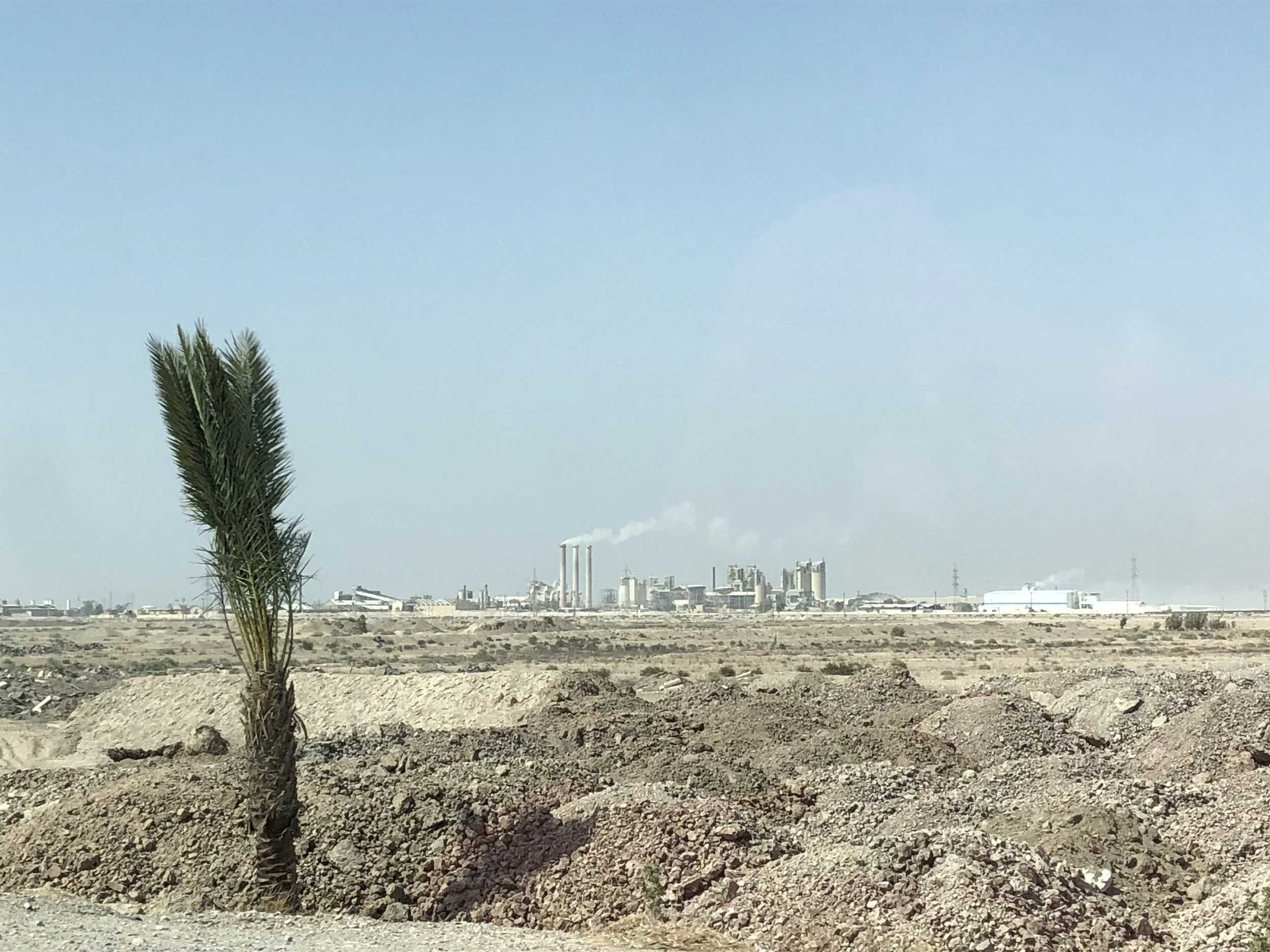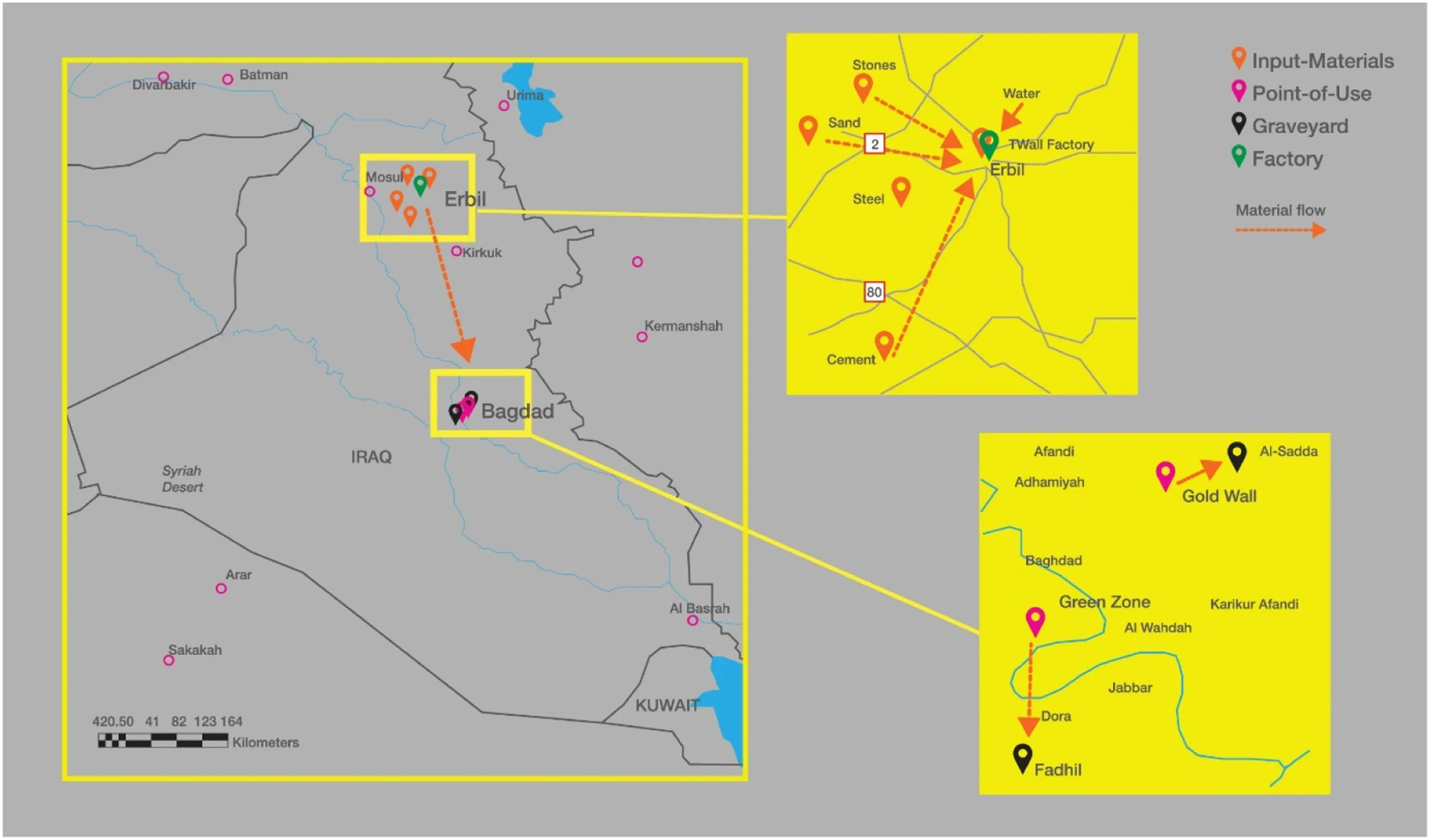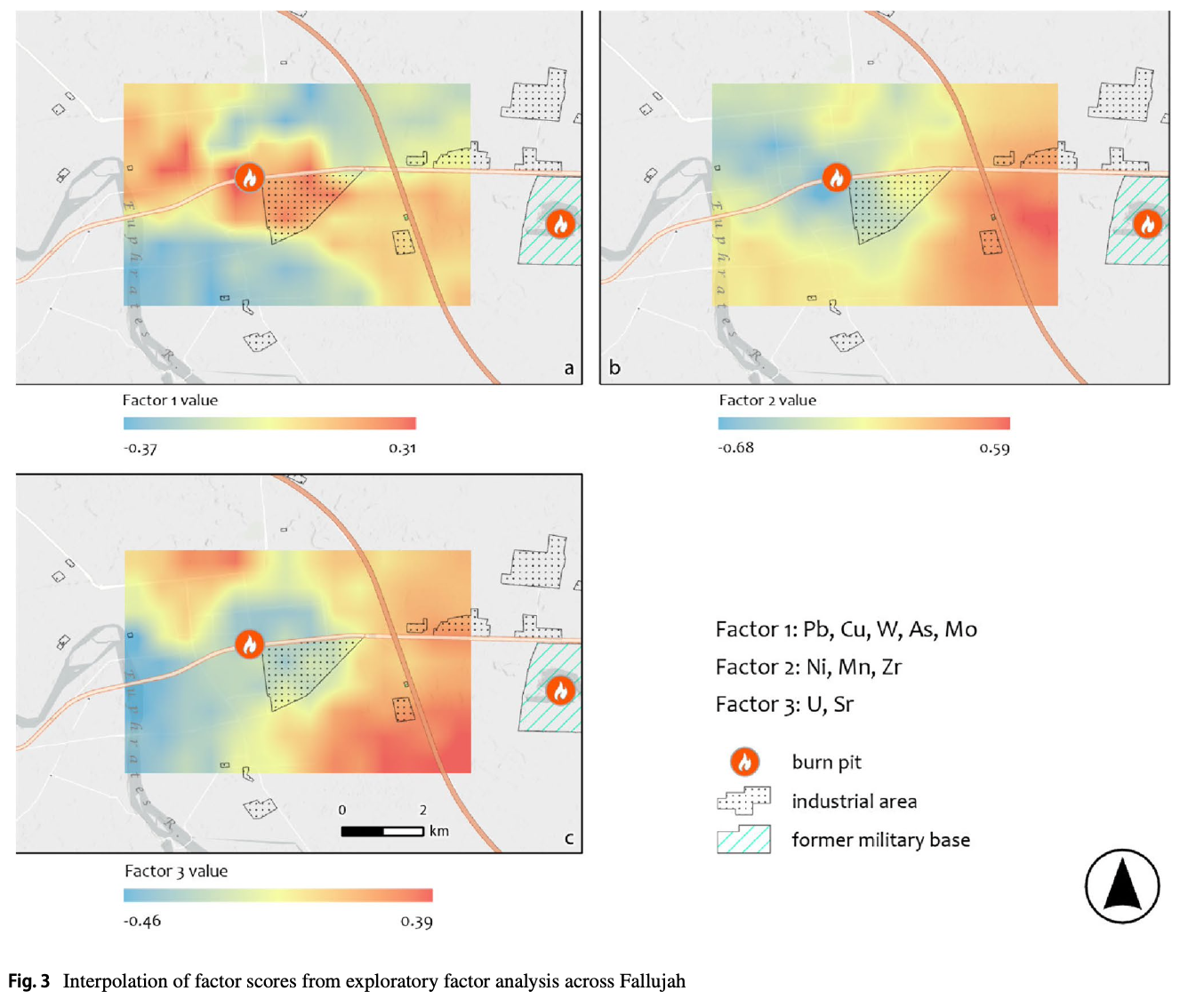HEALTH AND ENVIRONMENTAL IMPACTS OF WAR
Traces of military violence can be identified in ways that inform public health policy, environmental remediation, forensic accountability, and translocal knowledge sharing. In attempts to measure war’s effects, this public database makes research findings accessible to communities facing exposure to war and military industries.
-
Wells, Ellen M., Aaron Specht, Addison Vogt, Samira Alaani, Abdulqadar Alrawi, Ian Lindsay, and Kali Rubaii. 2025. “Bone Uranium and Lead Concentrations in Adults from Fallujah, Iraq.” Environmental Pollution 384: 126963.
https://doi.org/10.1016/j.envpol.2025.126963
Highlights:Mean bone Lead and Uranium were 21.2 μg/g (SD:11.2) and 1.4 μg/g (SD: 1.0), respectively.
Bone Lead was 300–2333 % higher than reported in community studies in North America.
This is the first time in vivo bone Uranium concentrations have been reported in humans.
Results suggest adults in Fallujah have substantial, long-term exposure to Lead and Uranium.
-
Specht, A. J., I. C. Lindsay, E. M. Wells, and others. 2025. “Spatial Distribution of Heavy Metal Contamination in Soils of Fallujah, Iraq.” Exposure and Health 17: 31–39.
https://doi.org/10.1007/s12403-024-00645-5
The city of Fallujah, Iraq experienced extensive bombardment during recent military conflicts. However, limited environmental sampling has occurred to assess potential contamination. This study aimed to measure soil concentrations of heavy metals across Fallujah to determine the current levels of environmental pollution. We collected 117 surface soil samples in a grid pattern across Fallujah. Samples were analyzed using X-ray fluorescence (XRF) to quantify the levels of 13 elements. Geographic information systems (GIS) mapping visualized the spatial distribution of metals. Exploratory factor analysis (EFA) identified contaminant groupings. Multiple heavy metals were detected at concerning levels, including uranium, thorium, lead, and arsenic. Uranium and thorium were elevated in several areas, indicating potential contamination from depleted uranium munitions. FA results pointed to two primary exposure sources: burn pits in central Fallujah and industrial activity in the east. This study revealed heavy metal contamination in Fallujah soil, likely arising from military activity and industrial sources. The presence of toxic metals like uranium and lead raises concerns about potential health risks for residents. Further environmental sampling and health screening are urgently needed to fully characterize exposures and consequences. Remediation and prevention strategies should address the complex environmental legacy of conflict in the region. -
Rubaii, Kali, Mark Griffiths, Ellen Wells, Aaron Specht, Ian Lindsay, Samira Alani, and Abdulqader Alrawi. 2024. “Lessons from Fallujah: War Returnees Face Long-Term Health Risks from Heavy Metal Exposure.” March 24. Watson Institute for International & Public Affairs at Brown University.
https://watson.brown.edu/costsofwar/files/cow/imce/papers/2025/Rubaii_Costs%20of%20War_Lessons%20from%20Fallujah_March%2024%2C%202025.pdf
Based on interdisciplinary biological, environmental, and anthropological research in Fallujah, Iraq, this study finds that people who return to bombarded homes and neighborhoods may face increased risk of negative health impacts from heavy metal exposure, both for themselves and for future generations. Our findings support prior research which has demonstrated that those who are first at the scenes of war-damaged areas may be at a higher risk of reproductive health harms, and that Fallujah’s population faced a 17-fold increase in birth anomalies and myriad other health problems linked with the 2003 U.S. invasion of Iraq. Our study demonstrates that exposure to remnants of war, amplified by vitamin deficiencies, may play a role in these health outcomes. -
Griffiths, Mark, and Kali Rubaii. 2024. “Late Modern War and the Geos: The Ecological ‘Beforemaths’ of Advanced Military Technologies.” Security Dialogue 56 (1): 38–57.
https://doi.org/10.1177/09670106241265636
This article develops the idea that late modern war’s relationship with the geos (the ground and the life it sustains) is doubly destructive. While part of this is recognized in a recent focus on slow violence and ecological aftermaths, there is little consideration of the ‘beforemath’, or the sites of extraction that make advanced military technologies possible. Drawing attention to mining in the Democratic Republic of the Congo (DRC), the article connects military technologies to arms manufacturers and their use of extracted minerals (e.g. cobalt, tantalum, copper, uranium). Shared patterns of environmental and public health effects across parts of Iraq, Gaza and the DRC indicate the doubly destructive nature of late modern war’s relationship with the geos: toxic materials threaten life after war as the deposits of bombardment and before war as mineral commodities at the beginning of arms supply chains. The article explicates how a perspective from the beforemath radically refigures the ways we think about war and spatiality, temporality, and the range of bodies affected in ways that promise a fuller understanding of the violence distributed by practices of late modern war. -
Larbi, Reuben, Benjamin Neimark, Kirsti Ashworth, and Kali Rubaii. 2025. “Parting the Fog of War: Assessing Military Greenhouse Gas Emissions from Below.” The Extractive Industries and Society 23.
https://doi.org/10.1016/j.exis.2025.101654.
The world's militaries account for up to 5.5 % of total global greenhouse emissions, yet there is still no requirement for governments to report these emissions in international climate agreements. Researchers are therefore left on their own to assess military emissions. This may seem like an incredibly daunting task. The lack of data is even more stark during periods of conflict, where reporting is relatively non-existent. This article sets out a novel framework for examining greenhouse gas emissions from military supply chains including situations where emissions data are difficult to acquire due to supply chain complexity, or when data are purposefully held back under the guise of national security. We provide an empirical study of supply chain-based carbon from the US military's use of concrete during the Second Iraq War (2003–08) to demonstrate its practicability. Concrete has a massive carbon footprint, and the US military uses a lot of it for protective walls, checkpoints, bases and bunkers. This work provides the tools to measure carbon embodied in military supply chains reinforcing recent calls for standardised frameworks emphasising the accounting of military environmental infrastructure footprints. -
Rubaii, Kali, and Mark Griffiths. 2025. “The Use of ‘Conflict Free’ Minerals in the Weapons Industry.” White paper for the Office of the UN Special Rapporteur on Toxics and Human Rights, Response to Call for Input – Military Activities and Toxics.
Response to Call for Input – Military Activities and Toxics. -
Rubaii, Kali and Mark Griffiths. 2025. “War Returnees Face Long-Term Health Risks from Heavy Metal Exposure,” white paper for Office of the UN Special Rapporteur on toxics and human rights.
Response to Call for Input – Military Activities and Toxics.
